Fig. 5. SC β cell proliferation and differentiation capacity of ZnPD6 are validated in a SF.

ZnPD6 shows higher efficacy than unmodified harmine in a scaled-up culture of SC β cells. (A) ZnPD6 identified from the DP is validated in SF for scaled-up SC β cell culture. (B) Treatment with ZnPD6 increases propensity of C-peptide and EdU copositive SC β cells as seen through representative immunofluorescent images of SC β cells with C-peptide (red), EdU (green), and nuclear staining (DAPI). White arrows indicate coincident cells (yellow). (C) EdU incorporation in monohormonal β cells treated with ZnPD6 is significantly higher compared to DMSO and harmine. Population of SC β cells (C-peptide+ GCG− EdU+) and SC α cells (C-peptide− GCG+ EdU+) treated in SF is obtained using flow cytometry (n = 4 or 6, *P < 0.05, **P < 0.01 versus DMSO, #P < 0.05 versus harmine). (D) ZnPD6 treatment in SF increases Nkx6.1 and insulin gene expression compared to DMSO and harmine group (n = 3, *P < 0.05, **P < 0.01 versus DMSO, #P < 0.05 versus harmine). (E) Insulin secretion in response to glucose stimulation (n = 7 to 9, **P < 0.01 versus 2.8 mM).
